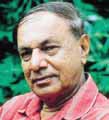
23rd April 2000
News/Comment|
Editorial/Opinion| Business| Sports|
Sports Plus| Mirror Magazine


Exhibition
The month of May will see the first-ever exhibition of Buddhist paintings by a Sri Lankan artist in Thailand. The man to be so honoured in a country which holds Theravada Buddhism in high esteem is Kalasuri Jayasiri Semage.In keeping with the spirit of Vesak, Semage has specially created some paintings with Buddhist themes such as 'Buduveema' (Glorious Victory), 'Mara Parajaya' (Defeat of Death), 'Vessanthara Ratha Dan Deema' (King Vessanthara donates vehicle) and 'Muchalinda Naga Dharanaya' (Buddha's sixth week).
 The
exhibition 'Cascade of Life' to be held at Sukhumvit Grand Sheraton Hotel
in Bangkok will feature 60 of his latest creations depicting Sri Lanka's
rural life, rural womenfolk and historic events, using oil paint, water
colours, acrylic paint and line drawings. These paintings will also be
displayed at the Carpodiem Galleries in Bangkok in June. The exhibition
is being organized by Sri Lanka's Ambassador in Thailand Karunathilaka
Amunugama.
The
exhibition 'Cascade of Life' to be held at Sukhumvit Grand Sheraton Hotel
in Bangkok will feature 60 of his latest creations depicting Sri Lanka's
rural life, rural womenfolk and historic events, using oil paint, water
colours, acrylic paint and line drawings. These paintings will also be
displayed at the Carpodiem Galleries in Bangkok in June. The exhibition
is being organized by Sri Lanka's Ambassador in Thailand Karunathilaka
Amunugama.
Taste of Sinhala - 16
What would we do without no,no?
By Prof. J. B. Disanayaka
It is customary among speakers of many languages to ask questions from listeners just to make sure of what they are saying. An English speaker does so by tagging a question at the end of any sentence for which he needs such reassurance.These 'tag questions' take different forms depending on the subject of the sentence:
The girl is pretty, isn't she?
You are a doctor, aren't you?
They are fools, aren't they?
There is always agreement between the nouns and verbs of the main sentence and those of the tag question, for no English speaker says: The girl is pretty, aren't they?
The Sinhala speaker has no such restrictions. He has only to tag the negative word "ne" to the end of the phrase or sentence, thus: kella lassanay ( The girl is pretty); Kella lassanay-ne (The girl is pretty,isn't she?); oya: dostara kenek (You are a doctor) and oya: dostara kenek, ne (You are a doctor, aren't you?).
This habit is transferred to Sri Lankan English too: The girl is pretty,
no? The girl is a doctor, no?

A human story
Walking into the Regal cinema the other day, it was indeed a pleasure to see so many children at a film, a Sinhala film at that. They were there to view the much talked of 'Saroja', though it is not necessarily a children's film. This movie which appeals to all ages discusses a contemporary issue - the war. It exposes terrorist tactics - how young Tamils are forced to toe the line. It warns the extremists on the need to take a balanced view. But above all, it tells us a human story - the need to be human rather than look for one's own kith and kin to offer help.'Saroja' is Somaratne Dissanayake's maiden effort at making a film. He has made a few teledramas ('Iti Pahan' was one) which have been received well. With 'Saroja' he joins the band of young film-makers who are interested in making good films amidst the vast junk being offered in the name of Sinhala cinema.
Even more than giving us a quality product, to me the director's achievement is the way he had got the two key characters - Saroja (Nityavani Kandasamy) and Varuni (Pramudi Karunaratne) - to perform to near perfection. One portrays a seven-year-old Tamil girl facing the tragedy of homelessness after her mother is burnt and her father grievously hurt in a shooting. The other is the kind-hearted eight-year-old Sinhala girl who is able to convince her parents on how to treat another human being.
Such fine performances are rarely seen in a Sinhala film. Dissanayake has been lucky in picking not one but two such talented child 'stars'. (He had confessed it was a tough task picking two out of 3,000 applications in response to a newspaper advertisement. Two hundred had been selected from the first round and the number brought down to eight in the final round). Even the other children do their parts well.
Perfect casting
The casting, on the whole, is perfect. Janaka Kumbukage, the village schoolteacher and Nita Fernando as his wife, play their roles convincingly. Janaka, having graduated from stage, has impressed us on the small screen as capable of handling any role with depth and maturity. Nita, of course, has matured as one from whom we can expect the best. Mervyn Mahesan as the wounded terrorist and Mahesh Perera, the uneasy villager also act very well.The three veterans - Joe Abeywickrema (Veda Mahattaya who smells all is not well in the schoolteacher's household), Tony Ranasinghe (the police inspector who takes a balanced view of the situation) and Ravindra Randeniya (the army major who is restrained in his actions) - give that extra touch. The film is a fine blend of top class acting, superb photography and fitting music score.








![]()
Front Page| News/Comment| Editorial/Opinion| Plus| Business| Sports| Sports Plus| Mirror Magazine
Please send your comments and suggestions on this web site to

